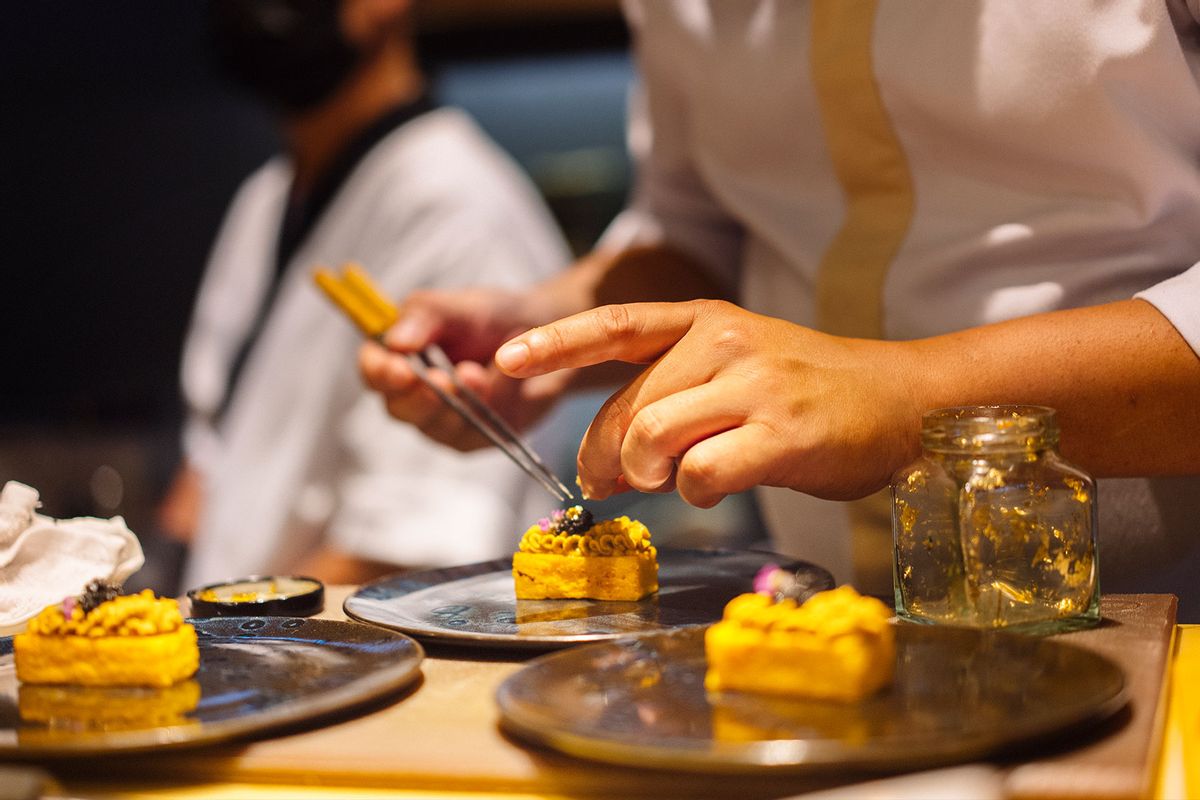Chef Nikki Zheng never planned to become a sushi chef. She always imagined herself on the line, but never considered sushi — a booming, highly coveted craft.
While working at Sushi of Gari in New York City, Zheng enjoyed her very first omakase with a few friends for Christmas dinner. “That day really changed my perception [of sushi],” she said. “I realized, ‘Wow, sushi can be so creative.’ And also, good sushi can bring people joy. It’s like a bridge that connects people.”
Today, Zheng is the mastermind behind the newly opened Sushi Akira, an intimate 12-seat, 18-course omakase experience on the Upper East Side. After starting her culinary journey in Tokyo at the three-Michelin-starred Quintessence, Zheng honed her craft at several high-end Japanese restaurants, including Sushi Nakazawa, Masa, Bar Masa, Sushi of Gari and Tsukimi.
“What made me stay was the pursuit of perfection,” Zheng said of her career beginnings. “I’ve always been drawn to precision and details. Sushi is all about that.”
Zheng is one of the few women leading her own omakase counter. In Japan — which is home to over 30,000 sushi restaurants — less than 10% of sushi chefs are women, said Makato Fukue, President of Tokyo Sushi Academy, Inc. Within the States, nearly 80% of sushi chefs are men and the number of women leading sushi counters is also low.
In a 2011 interview with the Wall Street Journal, Yoshikazu Ono — the son of Jiro Ono, one of the greatest living sushi masters in the world and subject of the hit documentary film, “Jiro Dreams of Sushi” — explained why he believed women are incapable of performing at the same level as their male counterparts. “Because women menstruate,” he said. “To be a professional means to have a steady taste in your food, but because of the menstrual cycle women have an imbalance in their taste, and that’s why women can’t be sushi chefs.” Other myths claim women have small hands, making them unable to shape sushi, and warmer hands, which ruins the texture of the rice and fish that they’re handling.
While these myths have long been disproven, their impact lingers. The gender gap within the industry remains prevalent. A 2022 report by the world Economic Forum, cited by Condé Nast Traveler, ranked Japan 116th out of 146 countries in the gender gap rankings. In 2023, Japan ranked 125th out of 146 countries on gender equality—the lowest since the World Economic Forum began tracking it, per the University of Tokyo.
Training as a sushi chef is notoriously rigorous, usually with long work hours and minimal work-life balance. Taking time off for parental leave is not only difficult to attain but a hindrance to a sushi chef’s career. Kasumi Takahashi, a female shokunin (or artisan) at Ginza Sushi Aoki told Condé Nast Traveler, “As I worked longer and longer, I became greedy for learning. Now I’m 39 years old, which is considered to be ‘old’ to be pregnant. Considering the timing is really difficult.”
We need your help to stay independent
“Beyond that, it’s harder for women to get opportunities in top sushi kitchens or restaurants,” Zheng said, explaining the strict hierarchy that’s in place within the culinary scene. “As a female sushi chef, you don’t have many opportunities to be an executive chef or a sous chef. It’s more of a challenge to break in.”
Zheng recalled several instances when she received skeptical glances and surprised looks from customers after they saw her behind the sushi counter. In other instances, customers questioned her abilities to serve and make sushi, underscoring outdated, discriminatory beliefs. “Yes, absolutely, I feel sad,” Zheng said. “But it’s not true, you know. I don’t try to explain myself. I just try my best and show them my skills.”
Want more great food writing and recipes? Subscribe to Salon Food's newsletter, The Bite.
“I try to prove that sushi is more about precision, skills and craftmanship, not about gender. Overall skills speak louder than gender for sushi and any kind of cuisine,” she added.
Zheng isn’t alone in her struggles. There’s chef Oona Tempest, who opened up about the challenges she faced as a white female chef breaking into the industry. “In the beginning I had a lot of customers that wouldn’t sit with me. Mainly, they didn’t want to sit with a non-Japanese chef,” she told Edible Manhattan, adding that she found both strength and courage in her mentor, the late chef Toshio Oguma of Tanoshi Sushi. There’s also chef Nanako Fujitani, who spoke about the hierarchy in restaurants along with the physical challenges she faced during her early years in the kitchen. “When I started as a chef, the hierarchy in restaurants was still very strict,” she told OpenTable. “I was an amateur and hadn’t attended culinary school, so I was scolded by my seniors every day no matter what I did.”
Zheng is humble in sharing the strides she’s made within the omakase industry. For aspiring female sushi chefs, she offered one piece of advice: “If you’re really passionate about sushi or omakase, please just believe in yourself. Don’t let outside voices discourage you. And don’t let gender bias discourage you as well.”
Read more
about women in food:



Shares